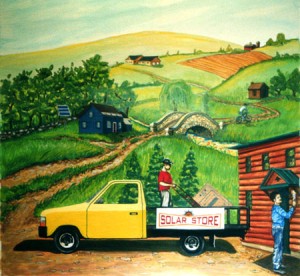Branding is tricky business.
It’s not enough to crisply differentiate a product, provide stellar service and reinforce your customers’ delusions of grandeur. The whims of the market might still bring you down.
That’s what’s happened with the Hummer. Say what you want about the make, now being euthanized by GM, but you can’t deny the brand’s potency. Huge. Tough. Dangerous. Cavalier. I am a force. Reckon with my a**.
The problem was, the brand couldn’t contain its own machismo. Like a downhill ski racer hurtling off the course, the machine’s daring was its downfall. Utterly and unapologetically ginormous, it came to stand for everything that’s wrong with our auto-addicted, fossil-fueling, high-beaming selves. As we used to chant on the playground, Hey! Hey! Get outta my way! I just got back from the USA!
Which reminds me, a buddy of mine rolled up on a sexy new BMC racing bicycle the other day. Beefy, squared-off tubes. Not to be messed with.
“Dude,” I said, “that baby is the Hummer of bikes.”
Like a good liberal, he blanched.
Oops, sorry, meant that as a compliment. He likes the bike because it’s Swiss.
Anyway, a pending deal to sell Hummer to a Chinese concern fell through this week, prompting GM to say it will begin the “orderly wind-down of the Hummer operations.” As with the other brand GM recently tried to retire, Saab, there’s a glimmer of hope. That would be of interest to the 3,000 people who make and sell Hummers in the US, including 950 who work at an already shrinking GM plant in Shreveport, La.
If the brand does collapse, you can’t blame it on the brand per se. Gas prices, recessionary times, heightened eco-consciousness and a more touchy-feely zeitgeist also played roles. But wait, that’s getting back to the brand, isn’t it?
After all, the Hummer isn’t the only vehicle that gets paltry mileage. In fact, the Hummer H3T at 16 mpg was green enough to get on the cash-for-clunkers trade-up list – not as a clunker but as an approved replacement. There’s a fair number of Audis and Beemers in that mileage range, and no one’s calling for their demise.
So maybe the Hummer got a bad rap. Or maybe it didn’t. Either way, the Hummer is gone (nearly). In the elegiac words of the Bard of Big, Hummerpedia.org:
This is the end, my only Hummer friend, the end. Bad news for those who love the H make. Gone, perhaps, but not forgotten.
It was a beast of a brand.





